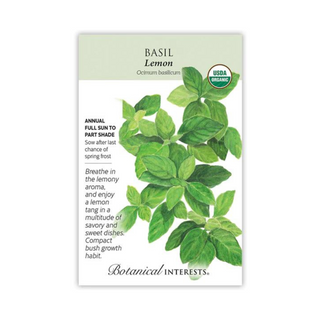
Description
There are dozens of ways to use lemon basil in the kitchen! It makes a great pesto or chiffonade to top fish or shrimp, adds an extra kick to flavored vinegars, is an excellent accompaniment to light pastas like capelli D'Angelo (angel hair) or farfalle (bow tie), and adds a tangy note to citrus or blueberry desserts. More compact than many other basil varieties, so it's perfect in small spaces. Can be grown indoors in a warm, south window! Recipe for basil herb oil inside packet.
Variety Info
- Family: Laminaceae
- Native: Probably Africa, but in cultivation for so long that it cannot be verified.
- Hardiness: Frost-sensitive annual
- Exposure: Full sun to part shade
- Plant Dimensions: 8"–16" tall, 20" wide. Low, spreading habit.
- Variety Info: 1 ½"–2" long, lime green, narrow, elliptical leaves with a strong, lemony scent and flavor. White flowers (if allowed to bloom). Lemon basil, also called Thai lemon basil or Lao basil, is used in traditional Indonesian, Laotian, and Thai cuisine.
- Attributes: Good for Containers
Sowing Info
- When to Sow Outside: 1 to 2 weeks after your average last frost date, and when soil temperature is at least 60°F, ideally 65°–85°F. Successive Sowings: We recommend 3 or 4 successive sowings every 3 weeks after initial sowing.
- When to Start Inside: RECOMMENDED. 4 to 6 weeks before transplanting outside. Transplant when your nighttime temperatures are above 50°F.
- Days to Emerge: 5 – 10 Days
- Seed Depth: ¼"
- Seed Spacing: A group of 2 seeds every 12"
- Row Spacing: 12"
- Thinning: When 2" tall, thin to 1 every 12"
Growing Info
- Harvesting: Basil flavor is best before the plant flowers. Harvest up to 1/3 of the plant at a time, leaving enough for the plant to be healthy and keep producing. Harvest prior to a frost; basil is very frost sensitive.
Description
There are dozens of ways to use lemon basil in the kitchen! It makes a great pesto or chiffonade to top fish or shrimp, adds an extra kick to flavored vinegars, is an excellent accompaniment to light pastas like capelli D'Angelo (angel hair) or farfalle (bow tie), and adds a tangy note to citrus or blueberry desserts. More compact than many other basil varieties, so it's perfect in small spaces. Can be grown indoors in a warm, south window! Recipe for basil herb oil inside packet.
Variety Info
- Family: Laminaceae
- Native: Probably Africa, but in cultivation for so long that it cannot be verified.
- Hardiness: Frost-sensitive annual
- Exposure: Full sun to part shade
- Plant Dimensions: 8"–16" tall, 20" wide. Low, spreading habit.
- Variety Info: 1 ½"–2" long, lime green, narrow, elliptical leaves with a strong, lemony scent and flavor. White flowers (if allowed to bloom). Lemon basil, also called Thai lemon basil or Lao basil, is used in traditional Indonesian, Laotian, and Thai cuisine.
- Attributes: Good for Containers
Sowing Info
- When to Sow Outside: 1 to 2 weeks after your average last frost date, and when soil temperature is at least 60°F, ideally 65°–85°F. Successive Sowings: We recommend 3 or 4 successive sowings every 3 weeks after initial sowing.
- When to Start Inside: RECOMMENDED. 4 to 6 weeks before transplanting outside. Transplant when your nighttime temperatures are above 50°F.
- Days to Emerge: 5 – 10 Days
- Seed Depth: ¼"
- Seed Spacing: A group of 2 seeds every 12"
- Row Spacing: 12"
- Thinning: When 2" tall, thin to 1 every 12"
Growing Info
- Harvesting: Basil flavor is best before the plant flowers. Harvest up to 1/3 of the plant at a time, leaving enough for the plant to be healthy and keep producing. Harvest prior to a frost; basil is very frost sensitive.

